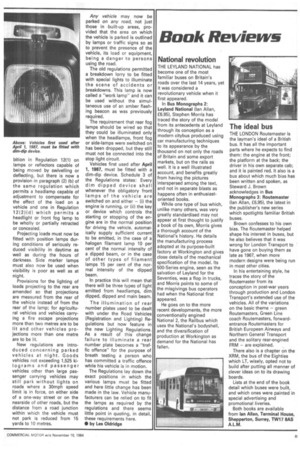Book Reviews
Page 71

If you've noticed an error in this article please click here to report it so we can fix it.
National revolution
THE LEYLAND NATIONAL has become one of the most familiar buses on Britain's roads over the last 14 years, yet it was considered a revolutionary vehicle when it first appeared.
In Bus Monographs 2: Leyland National (Ian Allan, £6.95), Stephen Morris has traced the story of the model from its antecedents at Leyland through its conception as a modern citybus produced using car manufacturing techniques to its appearance by the thousand on not only the roads of Britain and some export markets, but on the rails as well. It is a well illustrated account, and benefits greatly from having the pictures interspersed among the text, and not in separate blasts as happens often in enthusiastoriented books.
While one type of bus which, unlike many others, was very greatly standardised may not appear at first thought to justify a book of its own, Morris gives a thorough account of the National's history. He details the manufacturing process adopted at its purpose-built factory at Workington and gives close details of the mechanical specification of the model. Its 500-Series engine, seen as the salvation of Leyland for the Seventies, was a flop in trucks, and Morris points to some of the misgivings bus operators had when the National first appeared.
He goes on to the more recent developments, the more conventionally engined National 2, the Railbus which uses the National's bodyshell, and the diversification of production at Workington as demand for the National has fallen.
The ideal bus
THE LONDON Routemaster is the layman's ideal of a British bus. It has all the important parts where he expects to find them: the engine at the front; the platform at the back; the driver in his own separate cab; and it is painted red. It also is a bus about which much bias has been written and spoken, as Steward J. Brown acknowledges in Bus Monographs 3: Routemaster (Ian Allan, £6.95), the latest in the publisher's new series which spotlights familiar British buses.
Brown confesses to his own bias. The Routemaster helped shape his interest in buses, but he also believes that it was wrong for London Transport to have gone on buying them as late as 1967, when more modern designs were being run in most other cities.
In his entertaining style, he traces the story of the Routemaster from its conception in post-war years through production and London Transport's extended use of the vehicles. All of the variations on the basic theme — green Routemasters, Green Line coach Routemasters, forwardentrance Routemasters for British European Airways and Northern General Transport and the solitary rear-engined FRM — are explained.
There also is a chapter on the XRM, the bus of the Eighties which LT, wisely, opted not to build after putting all manner of clever ideas on to its drawing boards.
Lists at the end of the book detail which buses were built, and which ones were painted in special advertising and promotional liveries.
Both books are available from Ian Allan, Terminal House, Shepperton, Surrey, TVV17 8AS A.L.M.




































































































